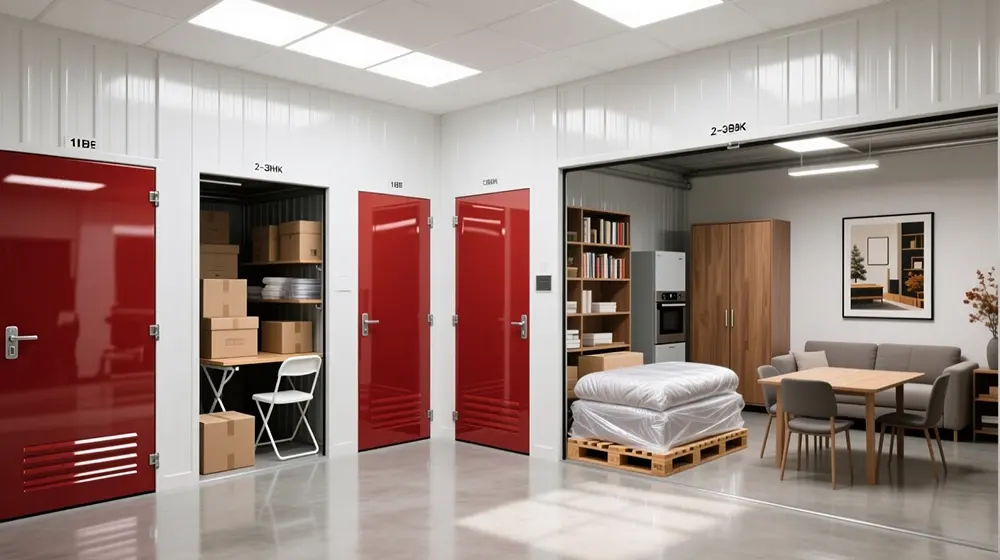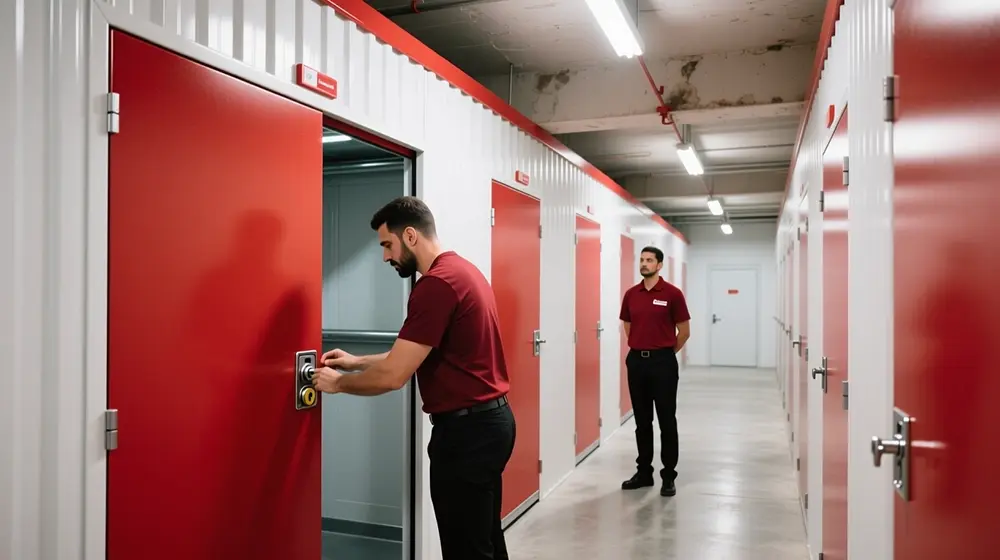Abu Dhabi’s rapid growth as an aviation and industrial hub is reshaping how travelers, businesses, and logistics operators think about storage. The network comprises Zayed International (AUH), Al Bateen Executive (AZI), Al Ain International (AAN), Sir Bani Yas (XSB), and Delma (ZDY). Each airport serves a distinct role that shapes demand for Abu Dhabi self storage near airports.
- Abu Dhabi Airports announced that it welcomed over 15.8 million passengers between 1st January and 30th June 2025, marking a notable 13.1 % increase compared to the same period in 2024. Zayed International Airport was the main driver of growth with 28.8 million passengers, up 28.2 % from 2023.
- Al Bateen Executive (AZI) is the only dedicated business-aviation airport in the Middle East and North Africa regions (MENA), supporting private jets and time-critical corporate movements.
- Al Ain International Airport (AAN) is the second airport in Abu Dhabi and serves Al Ain and nearby areas. AAN handles 100,000+ passengers/year, supports cargo, and serves the eastern region.
- Sir Bani Yas Airport (XSB) completed a runway, taxiway, and apron rehabilitation in February 2025, improving safety and night operations for eco-tourism links.
- Delma Airport (ZDY) links a ~45 km² island community to Abu Dhabi with a ~45-minute flight, sustaining essential connectivity.
This guide maps the best self storage locations in Abu Dhabi for airport users and manufacturers, highlighting Mussafah clusters close to AUH, ICAD gates, and KEZAD links so that you can cut turnaround times and costs. You’ll learn how to choose climate-controlled storage in Abu Dhabi, what to expect from 24/7 access storage units, and which compliance checks (Civil Defence approvals, insurance, item eligibility) to confirm before move-in.

Abu Dhabi airports and nearby self storage implications
Abu Dhabi operates a multi-airport system that directly shapes demand for self storage near airports. Each facility serves a unique role, from Zayed International Airport (AUH) to Al Bateen Executive (AZI) for private aviation, creating distinct storage needs. Understanding these roles helps identify where Abu Dhabi self storage solutions are most useful for travelers, businesses, and logistics operators.
| Airport | Primary role | Storage implications |
| Zayed International (AUH) | Main passenger & cargo hub | High airport-area self-storage for luggage, exhibitions, and aviation support. |
| Al Bateen Executive (AZI) | Business/private | Demand for secure, rapid-access units for crews, tools, and VIP logistics. |
| Al Ain International (AAN) | Regional + cargo | Regional firms use short-term storage for parts and event kits. |
| Sir Bani Yas (XSB) | Eco-tourism link | Tourism seasons trigger temporary storage for operators. |
| Delma Island (ZDY) | Community link | Community logistics benefit from modular storage on the mainland. |
How does traffic growth translate into storage demand near AUH?
Passenger growth increases short-term luggage staging and last-mile logistics, which raises demand for self storage near AUH. Abu Dhabi Airports recorded more than 15.8 million passengers in the first half of 2025, a 13.1 % increase over the same period in 2024, underscoring the aviation sector’s remarkable upward trajectory. Central to this growth is Zayed International Airport (AUH), which alone handled 15.5 million passengers between January and June, representing a 13.2 % year-on-year increase. AUH also recorded 93,858 aircraft movements during this period, up 11.4 per cent from 84,286 flights in the first half of 2024. These figures validate persistent throughput and intensify time-sensitive storage needs near Terminal A.
Signals for storage planners
- Peak processing at ~11,000 passengers/hour compresses curbside dwell time, shifting bulky items off-airport.
- Network resilience during disruptions keeps flows stable, which sustains baseline demand for off-airport units.
Where do airport-adjacent storage clusters actually form?
Most Abu Dhabi self storage clusters sit in Mussafah, aligning with AUH access roads and ICAD gates. Operators publish precise addresses that allow route planning from AUH or industrial estates.
Nearby Abu Dhabi Self Storage Providers
Several Abu Dhabi self storage companies operate near AUH, ICAD, and Mussafah, giving travelers and businesses convenient, flexible options. Always verify details, fees, and compliance before booking.
| Features | Use cases |
| 24/7 access; pickup/delivery contacts | Layover luggage; event kits; SME overflow |
| Climate control; 24-h call line | Personal storage; seasonal holds |
| Climate-controlled units; CCTV | Electronics, archives, light inventory |
Which industrial estates generate the biggest storage spillovers?
KEZAD Group and ICAD/Mussafah anchor industrial demand that spills into flexible self storage. KEZAD integrates 12 zones over ~550 km², with 2,100+ clients, USD 18B+ FDI, and USD 45B+ total investments; ICAD spans ~40 km² with dedicated clusters. Both ecosystems shape where Abu Dhabi self storage near industrial estates works best.
Industrial estates and logistics context
Abu Dhabi’s key industrial zones, KEZAD Group and ICAD/Mussafah, anchor regional manufacturing and logistics, creating steady demand for self storage near airports and industrial estates. Their scale, sector focus, and infrastructure links shape where businesses and SMEs choose flexible Abu Dhabi self storage solutions.
| Estate | Scale & tenants | Sector focus | Advantage |
| KEZAD Group | ~550 km², 12 zones, 2,100+ clients; 540,000 m² warehouses | Metals, polymers, food, automotive, logistics | Adjoins Khalifa Port; highway and rail links |
| ICAD/Mussafah | ~40 km²; multiple clusters | Fabrication, warehousing, assembly | Mature roads, proximity to the city, and ports |

Additional KEZAD indicators
- 55% of the UAE industrial area is attributed across KEZAD zones.
- Strategic corridor on E11; new KEZAD Business District enhances mixed-use capability for operators.
What market data supports using self storage instead of more warehouse space?
Industrial and logistics requirements surged, rents rose, and Grade-A space tightened, which makes self storage an efficient relief valve. Knight Frank recorded ~18 million sq ft of H1-2024 requirements (+185% YoY), Grade-A rents rising from AED 33 psf to AED 65 psf, and instances at AED 100 psf. These shifts elevate the appeal of short-term Abu Dhabi self storage near industrial estates for overflow.
- A 2024/25 review adds submarket rent growth and confirms strong UAE-wide demand momentum.
- Separate market notes show continued occupier pressure and low vacancy, consistent with the self-storage substitution effect for SMEs.
How does KEZAD’s scale change the calculus for storage location?
A 550 km² industrial platform adjacent to deep-water port access shifts “optimal storage” south-east of the city toward KEZAD/ICAD. The integrated free-zone + domestic models combine heavy manufacturing, logistics, and staff accommodation at a national scale. Modular, climate-controlled self storage near estate gates absorbs short cycles, marketing kits, and spare parts.
- Infrastructure and digital projects announced in 2024/25 further consolidate industrial activity in KEZAD.
- Media and industry features consistently cite KEZAD’s 550 km² and 12 zones profile.
Which self storage features are essential for industrial users?
Industrial users prioritize:
- Access
- Protection
- Compliance
The first line of due diligence is fire code alignment, followed by documented security, climate, and contract transparency.
Business Checklist for Abu Dhabi Self Storage Near Airports & Industrial Estates
Plan your Abu Dhabi self storage like an operations tool, align unit features with AUH Terminal A flight windows, and ICAD/KEZAD production shifts for predictable turnaround. Keep contracts transparent under Dubai consumer protection guidance and verify Civil Defence compliance before move-in. Screen inventory against UAE customs restrictions if any bonded or re-export activity is involved.
- 24/7 access
- Drive-up bays
- CCTV with logs (reduce downtime)
Confirm these service levels in writing and retain proof as part of your consumer-protection trail.
- Sprinklers
- Detectors
- Clear egress
- Civil Defence Approvals (per the UAE Fire & Life Safety Code of Practice)
Ask the facility for current approvals and reference the published Code.
- Written quotes
- After-hours fees
- Delivery fees
- Confirm insurance responsibilities
Many Abu Dhabi providers publish request-a-quote flows and 24/7 access terms; use them to document exact charges.
- Item eligibility (checked against banned/restricted lists)
- Private customs-warehouse rules (if bonded storage is involved)
Validate goods against the UAE Government Portal and Abu Dhabi Customs guidance; apply for private customs warehouse licensing when required.
What about travelers? Why store near AUH instead of carrying everything?
Self storage near AUH reduces friction for long layovers, multi-leg itineraries, and exhibitions. Terminal A’s capacity and peak throughput compress dwell time, which favors off-airport storage for bulky or multi-day items.
Traveler use cases
- Layover luggage offloaded for a same-day city visit.
- Event and expo materials staged near AUH for precise pickup windows.
- Sporting equipment stored between desert or island trips.
On-airport services vs off-airport self storage
Compute total trip cost and time, then add risk and liability. Off-airport units often win on multi-day value and access hours; on-airport counters win for very short holding times. Delivery or pickup from storage facilities can rebalance the choice. Verify terms with providers.
Decision heuristic
- Trip length ≤ 12 hours: Check on-airport desk first, then compare.
- Trip length ≥ 24–72 hours: Off-airport daily rate + 24/7 access often dominates.
- Bulky/oversize items: Favor off-airport with drive-up access.

Which neighborhoods keep both airport and estate access practical?
Mussafah (M26, M34) centralizes Abu Dhabi self storage near airports and industrial estates. The belt connects efficiently to ICAD, AUH, and city arteries. Published addresses confirm site density.
Cluster traits
- M34: High density of logistics and storage SMEs; StorageME address is Corner of 15/16 Streets.
- M26: Estate-facing nodes; Simple Storage lists Store 2, behind Nisto, M26.
- M-34 to ICAD corridors: Quick movement of spares, tooling, and documents to factory floors.
What permits and rules apply to storage and warehouses in Abu Dhabi?
Use the Abu Dhabi government’s TAMM portal for warehouse permits, and align facilities with the Civil Defence fire code and customs rules. Storage users reduce risk by confirming operator compliance before moving goods.
- Request a New Warehouse Project and Drawing Approval (TAMM).
- UAE Fire & Life Safety Code of Practice (Ministry of Interior/Civil Defence)
- Banned & restricted goods (Official UAE portal) and Abu Dhabi Customs guidance, including private customs warehouse licensing.
Bonded storage or dangerous goods require explicit licensing or specialized facilities under customs and port policies.
What KPIs should a business track when using self storage as flexible capacity?
A simple control panel keeps storage effective. Lower total logistics cost and higher service levels justify the model.
- Time to retrieve (TTR): Door-to-dock minutes.
- Unit utilization: % of rented m² actually filled; target >80% by week 2.
- Damage/incident rate: Per 1,000 items; trend down post climate-control.
- Compliance events: 0 missed inspections; 0 unauthorized items.
Support these with Civil Defence inspection records and inventory logs.
How can SMEs model the rent vs storage tradeoff?
When Grade-A warehouse rents rise to AED 65 psf with peaks near AED 100 psf, SMEs avoid long commitments by shifting swing capacity into self storage. In H1-2024, ~18M sq ft of requirements increased competition; many occupiers adopted hybrid models.
Hybrid model
- Keep core SKUs in the leased warehouse.
- Place seasonal, bulky, or project-based items in Mussafah self storage for 30–120 days.
- Use pickup/delivery or drive-up to balance labor cost.
Operational Checklist for Abu Dhabi Self Storage Near Airports & Industrial Estates
Use this operational checklist to align Abu Dhabi self storage with airport operations (AUH Terminal A) and industrial estates (ICAD, KEZAD) for predictable access and compliance. Terminal A can process ~11,000 passengers per hour, so tight access windows prevent delays for traveler luggage and aviation-adjacent cargo. Confirm safety and documentation standards before move-in to avoid bottlenecks at gates, inspections, and customs controls across Abu Dhabi airports and industrial estates. Document responsibilities with operators and keep records current for audits and cross-checks.
- Access hours match flight or shift schedules
Verify against live AUH departures/arrivals or airline status feeds so storage access aligns with crew rotas and factory shifts.
- Loading doors accept your tallest crates or racks
Confirm clear heights, bay widths, and turning radii per Abu Dhabi Civil Defence prevention and safety guidance for storage occupancies.
- Insurance and inventory rules signed and archived (Abu Dhabi Customs)
Record item eligibility, restricted goods screening, and any bonded-warehouse requirements using the Abu Dhabi Customs and federal customs portals.
Link between airports, estates, and storage
Case pattern: AUH event week
- Marketing kits arrive at AUH.
- Kits move to the Mussafah unit for 48–72 hours of staging.
- Team retrieves on event day; returns to storage; dispatches via Khalifa Port if needed.
This pattern repeats with predictable time savings and lower damage risk due to climate control.
Case pattern: ICAD spare parts buffer
- Vendor keeps critical spares in a nearby M26/M34 unit.
- When a line stops, parts arrive the same day, avoiding stockouts.
- Once the main warehouse expands, the unit scales down.
What’s the one-page selection guide for Abu Dhabi self storage near airports and estates?
Select by location, compliance, climate, and contract clarity. If two providers tie, choose the one with better access control and logs.

One-page guide
- Within your route: AUH ↔ Mussafah/ICAD/KEZAD corridors.
- Civil Defence: Compliance is visible and current.
- Climate control: For electronics, paper, and instruments.
- 24/7 access: Drive-up, CCTV + logs.
- Contract: Lists all fees; insurance is documented.
Final Thoughts: Why Abu Dhabi Self Storage Near Airports and Industrial Estates Matters
Abu Dhabi’s aviation and industrial ecosystems create one of the strongest regional cases for self storage near airports and industrial estates. Whether you’re looking for luggage storage near AUH between flights, staging expo kits and tooling for events, or adding flexible capacity during rent spikes, this Abu Dhabi self storage guide shows where to find reliable providers, how to compare on-airport services vs off-airport units, and which features matter most for safe, efficient operations across the AUH–Mussafah–ICAD–KEZAD corridor. For SMEs and manufacturers, it delivers flexible, scalable storage that avoids the cost of long leases. By choosing climate-controlled, 24/7-access units with Civil Defence certification, both travelers and businesses gain secure and efficient capacity inside Abu Dhabi’s busiest corridors.
Frequently Asked Questions (FAQs)
Where are the main self storage clusters near AUH and industrial estates in Abu Dhabi?
Most clusters are in Mussafah (M26, M34), within 21–26 km of AUH and directly linked to ICAD and KEZAD.
Why choose self storage near an airport instead of carrying luggage through the city?
AUH processed 15.5 million passengers in H1 2025 alone, which compresses curbside and terminal time; off-airport storage reduces congestion for layovers and bulky bags.
Which industrial estates create the most storage demand in Abu Dhabi?
KEZAD Group covers 550 km² with 12 economic zones, and ICAD spans 40 km², together driving the largest self storage spillover near Mussafah.
What features should businesses prioritize in nearby self storage units?
With industrial rents peaking near AED 100 psf, businesses must seek climate control, 24/7 access, CCTV with logs, and Civil Defence compliance to safeguard assets.
What unit features matter for travelers using self storage near AUH?
For 29.4 million annual travelers, essential features are short-term daily rentals, climate-controlled luggage space, late-night access, and drive-up bays.
How do I decide between on-airport baggage services and off-airport self storage?
DXB and AUH both provide on-airport baggage counters, but off-airport units near Mussafah are usually more cost-efficient for 24–72 hour holds and bulky luggage.
What documents or confirmations should I request before move-in?
Always ask for a written rental quote, insurance details, Civil Defence approval, and inventory eligibility rules.
Are dangerous or restricted goods allowed in Abu Dhabi self storage?
No. Restricted and hazardous goods listed under UAE Customs rules require special permits and cannot be stored in standard self storage.
What distance or time qualifies as “nearby” for airport-adjacent storage?
Storage is considered nearby when it lies within 15–25 km or 20–35 minutes of AUH, a corridor served by Mussafah units.
How can SMEs use nearby self storage to manage rent pressure and demand spikes?
With industrial demand rising +185% YoY, SMEs balance costs by keeping core stock in warehouses and overflow inventory in self storage units for 30–120 days.










